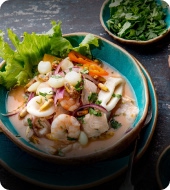
How to get off the beaten path in Peru
Written by:Valencia Travel
Last Update: 2025-01-04
Of course, most people want to visit Machu Picchu or the floating Islands on Lake Titicaca on their Peruvian vacation, however what happens if you are looking for a remote more off the beaten path experience and to get away from all the tourist traffic? Here are a few remote Peru attractions to get off the beaten path.

Native weavers in Cajamarca
Spend time in Madre de Dios.
While the majority of travellers hoping to experience the Amazon head straight to Iquitos, much fewer people visit the Amazon regions surrounding the Madre de Dios River, namely the Tambopata National Reserve and Manu National Reserve. Most lodges are about an hour to three hours downstream from Puerto Maldonado, the main town of Madre de Dios and where most people arrive to.
Slip on those high rubber boots to hike through the mud, explore the jungle, especially by flashlight at night for the best experience, paddle around hidden lakes, and fish for piranhas. You can spot the shining eyes of the caimans in the Madre de Dios during evening boat rides, listen to the locals’ eerie stories about the Chullachaqui, and even participate in an ayahuasca ritual in a recommended lodge.

Parrots on a claylick in Tambopata
Arrange a homestay in the village of Vicos.
Vicos is a small village found at the foothills of the highest mountain in Peru, the Huascarán. The population of Vicos is a little over 1,000, made up primarily of agriculturists. By arranging a homestay in Vicos, you will live like a local. Drink coca tea, work on the farm with the family, cutting wheat and herding sheep, immerse yourself in the traditional cooking techniques and taste the cuisine, which includes papakashki, an Andean potato soup. The way of life in this town hasn’t been affected by tourism and is an experience most will never have the chance to enjoy.

Laguna Paron, Huascaran
Visit Choquequirao archaeological site, Machu Picchu´s sister.
Nearly everyone who visits Peru makes Machu Picchu the main stop of the trip. It’s an incredible site that you will share with thousands of other tourists. Choquequirao, on the other hand, is a rediscovered Inca city in the Cusco region, still under excavation and reached by a strenuous two-to-three-day hike from the village of Cachora and visited by only a handful of adventurers daily. Similar to Machu Picchu in overall structure, Choquequirao is still being uncovered and archaeologists can sometimes be seen working at the site.
This is a low altitude trek for the Andes however the steep ascents and descents along The Choquequirao trek, require a decent level of fitness.

Choquequirao
Lake Akilpo via Huaraz.
A little-known journey to Lake Akilpo from Huaraz in Peru’s Ancash region isn’t an easy one, mainly due to the high altitude. The lengthy hike takes trekkers through a mountain pass, a quenua forest and an impressive valley. Unless you’ve been climbing mountains at altitude regularly, you will want to go slow and get plenty of rest on the overnight. Day two entails a roughly two-hour hike to reach Lake Akilpo, a glacier-fed lake reminiscent of Canada’s Moraine Lake with its transparent blue colour. This is the perfect hike of you are looking to get away from the crowds.

Lake Akilpo
Visit Cusco’s Baratillo Market.
You’re probably thinking Cusco is totally "on the beath path" and, yes, much of it is. The Plaza de Armas has international chain restaurants and high-end hotels. However, if you go strolling you may just bump into the Baratillo Market with its never-ending change of location Cusco´s “black market” has every sort of item you can imagine, from jeans to blenders, but not as many travellers as locals. Show up early and make sure to keep a hand on your wallet. If you are not looking to roam so far off the beaten path in Cusco, then give the San Pedro Market a visit and try the caldo de gallina for lunch with a fresh fruit juice.

Baratillo, Cusco
Take in the views of Lake Titicaca from Llachón.
If you’re looking to experience Lake Titicaca without a visit to Puno, visit Llachón, a village about 75km to the northeast. Visitors can typically show up and find a family to stay with without booking ahead. The quiet lakeside village isn’t a typical tourist haunt, and the vibe reflects that. Sleep in a small guesthouse for the evening and spend your morning kayaking on the lake. The experience is rather refreshing if you have already visited the floating islands of Lake Titicaca or the party scene in nearby Copacabana, in Bolivia.

View over Titicaca from Llachon
Huanchaco
Trujillo could easily be described as a low-key fishing town if it wasn’t for the fact that nearby is the sprawling pre-Inca complex of Chan Chan. Trujillo was the largest of its kind of its time in making the small nearby town of Huanchaco a stop on many a travellers list before heading south to Lima. Huanchaco is great for those looking to practice some surfing and eat delicious seafood and enjoy the ocean will hardly any tourists and take in its relaxed seaside vibe.

Huanchaco Beach
Appreciate the architecture of Cajamarca’s churches.
A small city in the Peruvian highlands, Cajamarca isn’t visited by many tourists but remains well known for its architecture, in particular, six Christian churches built in the Spanish colonial style. The city is also known as a centre of Carnaval celebrations, when Peruvians and (some) tourists visit the city of Cajamarca to celebrate before the easter celebrations.

 Aventure
Aventure
 Cultural
Cultural
 Gastronomy
Gastronomy
 Wellness
Wellness
 Local Living
Local Living
 Luxury
Luxury







